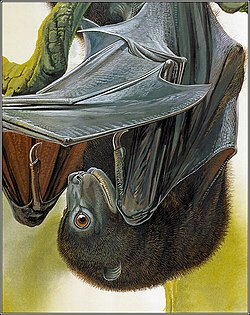Conservation
In 1992, this species was feared extinct because it had not been seen despite research expeditions in the area. [9] However, a research expedition in 1995 documented six individuals over the course of six months. [2] In 1992, captive breeding was recommended for this species, as its population was thought to be in drastic decline. [9] However, as of 2017, there is no evidence of such a program existing, or plans to initiate one. The species is on the IUCN Red List as an Endangered species. Threats to this species include habitat destruction from agriculture. It is also hunted for bushmeat. [1] In 2013, Bat Conservation International listed this species as one of the 35 species of its worldwide priority list of conservation. [10]
Efforts by Bat Conservation International to conserve the species include partnering with the indigenous Rotokas people, Volunteer Service Abroad, and the Bougainville Bureau for the Environment to develop a conservation plan for Kunua Plains & Mount Balbi Key Biodiversity Area. These efforts are intended to conserve the Bougainville monkey-faced bat and the greater monkey-faced bat. [11] Conservation actions identified by Bat Conservation International include identifying alternate protein sources for indigenous peoples so that they do not have to rely on bushmeat, creating native tree nurseries for reforestation efforts, mitigating conflicts between the fruit-eating bats and farmers seeking to protect their crops, and engaging the community more frequently in conservation dialogue. Researchers seeking to work in Kunua Plains & Mount Balbi Key Biodiversity Area will pay the Rotokas people for access to their land, hire guides and porters from local villages, and purchase their produce locally to provide income for the Rotokas people. [12]
This page is based on this
Wikipedia article Text is available under the
CC BY-SA 4.0 license; additional terms may apply.
Images, videos and audio are available under their respective licenses.


